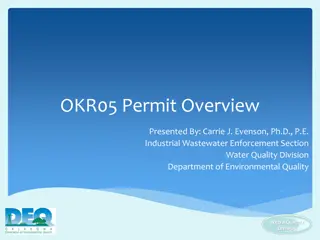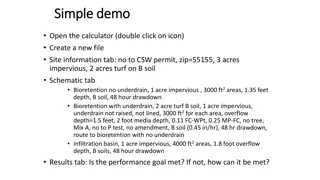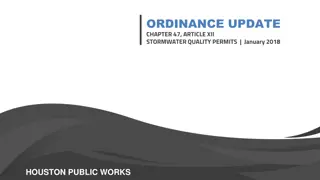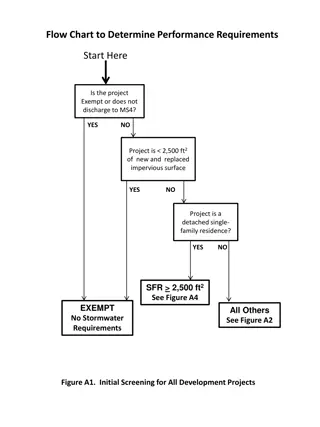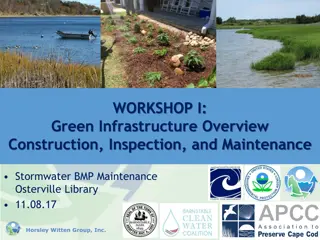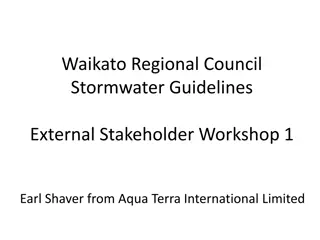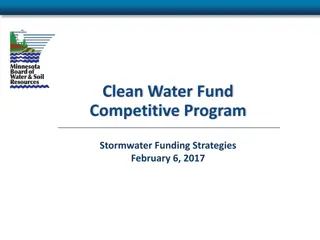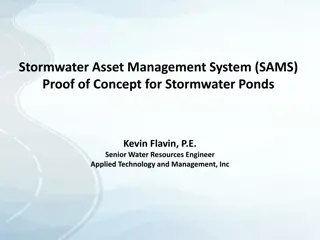Managing Stormwater in Infrastructure & Transport Planning: A Comprehensive Overview
Stormwater management is crucial for urban areas like Delhi due to heavy rainfall patterns and the risk of flooding. Factors influencing rainfall, runoff estimation methods, and water stagnation points are discussed. The importance of natural drainage systems in mitigating flooding is emphasized.
- Stormwater management
- Infrastructure planning
- Urban flooding
- Natural drainage systems
- Runoff estimation
Download Presentation

Please find below an Image/Link to download the presentation.
The content on the website is provided AS IS for your information and personal use only. It may not be sold, licensed, or shared on other websites without obtaining consent from the author. Download presentation by click this link. If you encounter any issues during the download, it is possible that the publisher has removed the file from their server.
E N D
Presentation Transcript
STORM WATER Subject: Infrastructure and Transport Planning Topic: Storm Water Presented by: Aditi Arora
i n f r a s t r u c t u r e RAINFALL DATA INTERPRETATION The average annual rainfall in Delhi is 714 mm, three-fourths of which falls in July, August and September. Heavy rainfall in the catchment area of the Yamuna can result in a dangerous flood situation for the city. In Delhi area, there are many factors which influence the rainfall, such as geographic position, Monsoon, topographic, and other factor, periodic or non periodic such as ENSO, QBO and tropical disturbance event. These factors could collaborate in complex manner to contribute the rainfall.
i n f r a s t r u c t u r e During rainfall periods there can be a considerable amount of storm water that does not infiltrate into the ground surface and most of this becomes the excess overland flow or direct surface runoff. There are many contributing factors for analyzing the quantity and temporal variations of this flow; these include geology of the land, topography, geography, rainfall intensity and pattern and the land use type. Estimation of such runoff reaching the storm sewers, is dependent on the intensity and duration of precipitation, characteristics of the tributary area and the time required for such flow to reach the sewer. There are various methods available to calculate the runoff, the two of the below mentioned methods can be adopted to calculate runoff: 1. Rational Method 2. Kirpich Equation Method 2) Tc = 0.01947 X L0.77 S-0.385 Where: Tc = Time of concentration (hours) L = Maximum length of water travel (m) S = surface slope, given by H/L (m/m) H = difference in elevation between the remotest point in the drainage basin and the outlet (m) 1) Q= 10 C i A Where Q is the runoff in m3/hr; C is the coefficient of runoff i is the intensity of in mm/hr and A is the area drainage district in hectares
i n f r a s t r u c t u r e POINTS OF WATER STAGNATION Water stagnation occurs when water stops flowing. Stagnant water can be a major environmental hazard. Stagnant water may be classified into the following basic, although overlapping, types: Water body stagnation: stagnation in swamps, lakes, lagoons, rivers, etc. Surface and ground water stagnation; puddles Trapped water stagnation. The water may be trapped in human artifacts (discarded cans, plant pots, tires, dug-outs, roofs, etc.), as well as in natural containers, such as hollow tree trunks, leaf sheaths, etc. To avoid ground and surface water stagnation, drainage of surface and subsoil is advised. Areas with a shallow water table are more susceptible to ground water stagnation due to the lower availability of natural soil drainage. Excessive watering may cause ground or surface water stagnation.
i n f r a s t r u c t u r e SYSTEM OF NATURAL DRAINS Natural Drainage System The city has been divided into six drainage zones (i) Northern Zone, (ii) Western Zone, (iii) Central North West and South East Zone, (iv) Central South and South East Zone, (v) East Zone and (vi) South Zone. The length of natural drain in the city is 350 km carrying discharge of 1000 CUSEC. However, most of the water collected through different drainage systems finally get discharged into the river Yamuna






